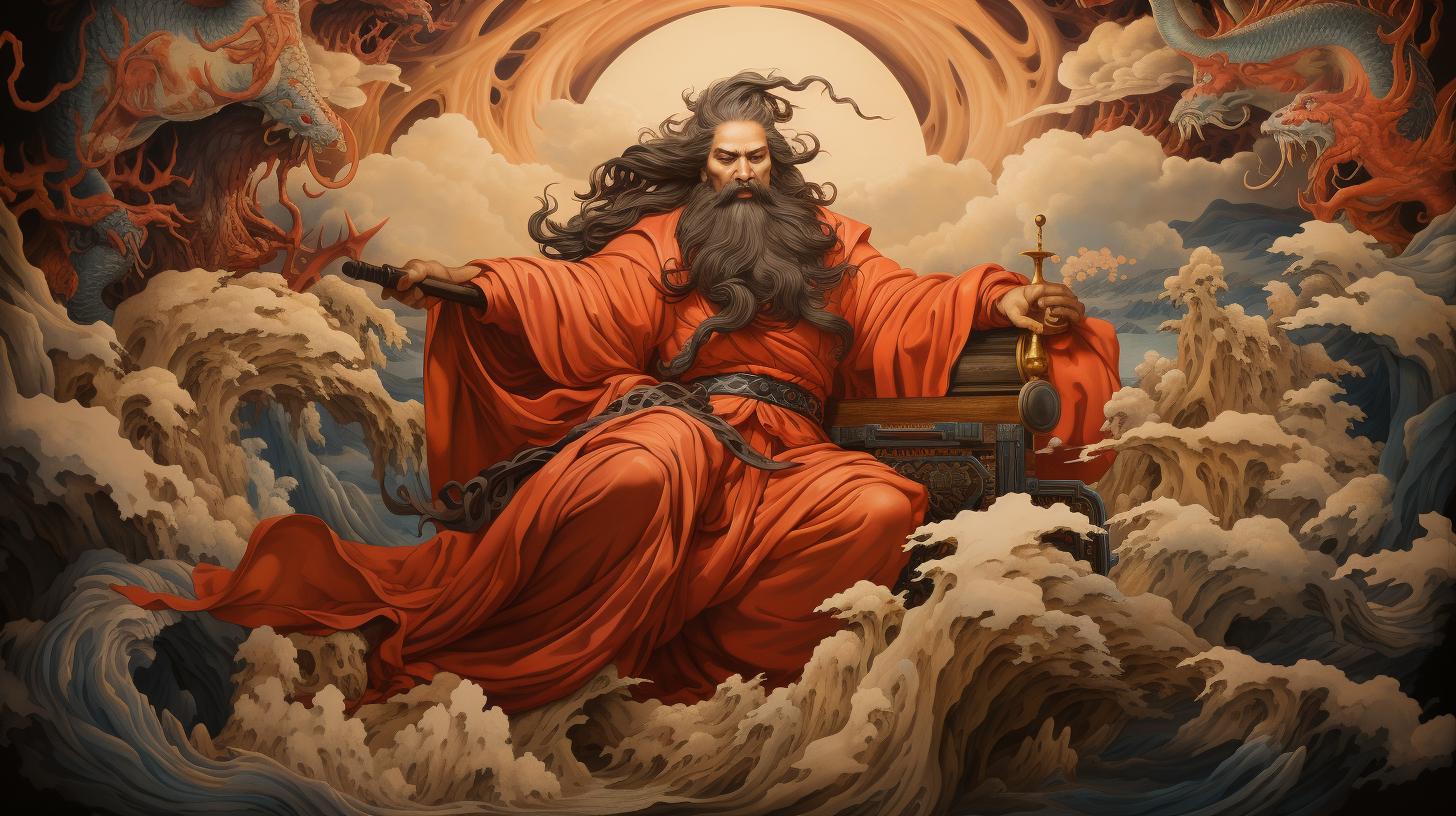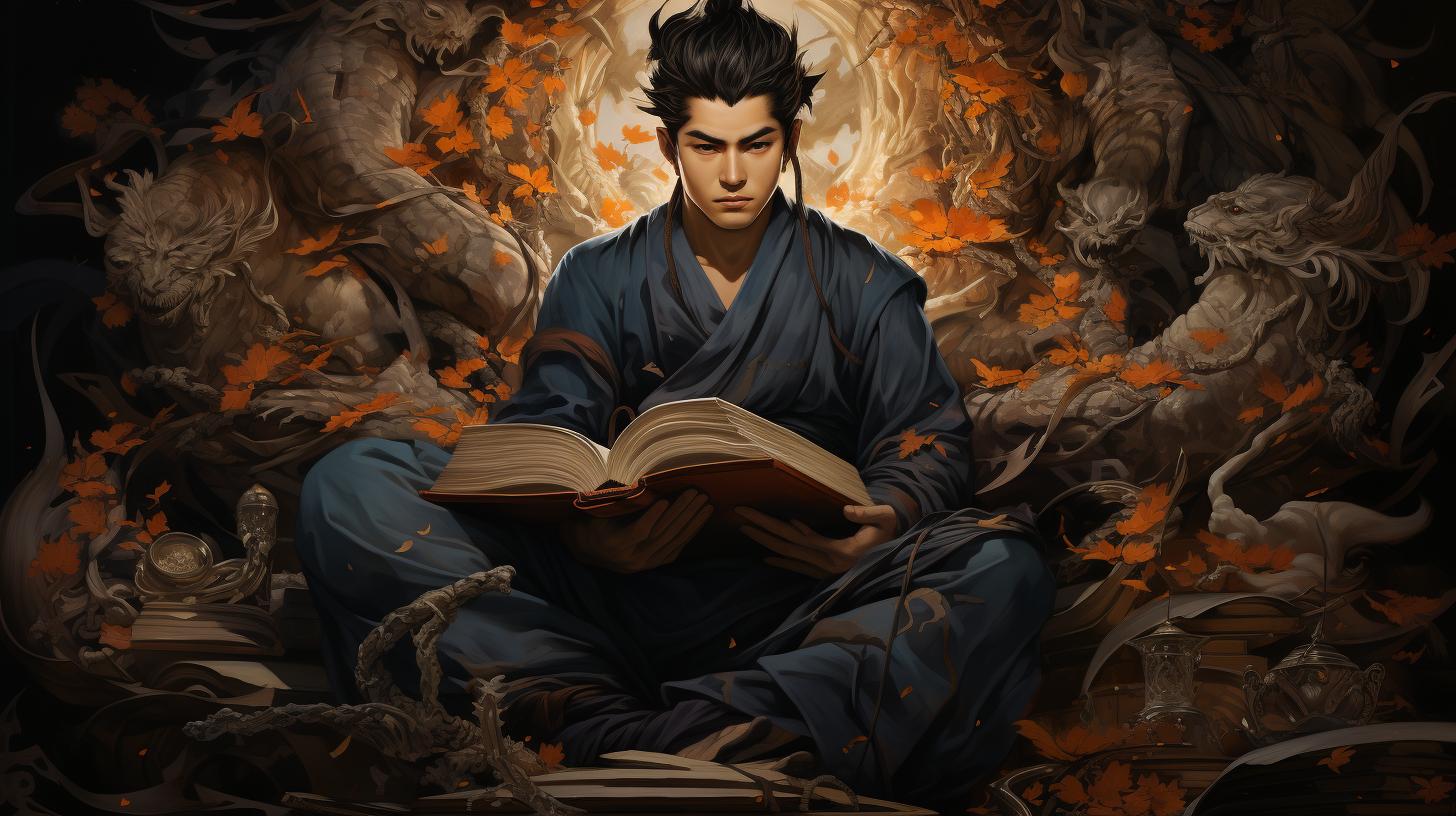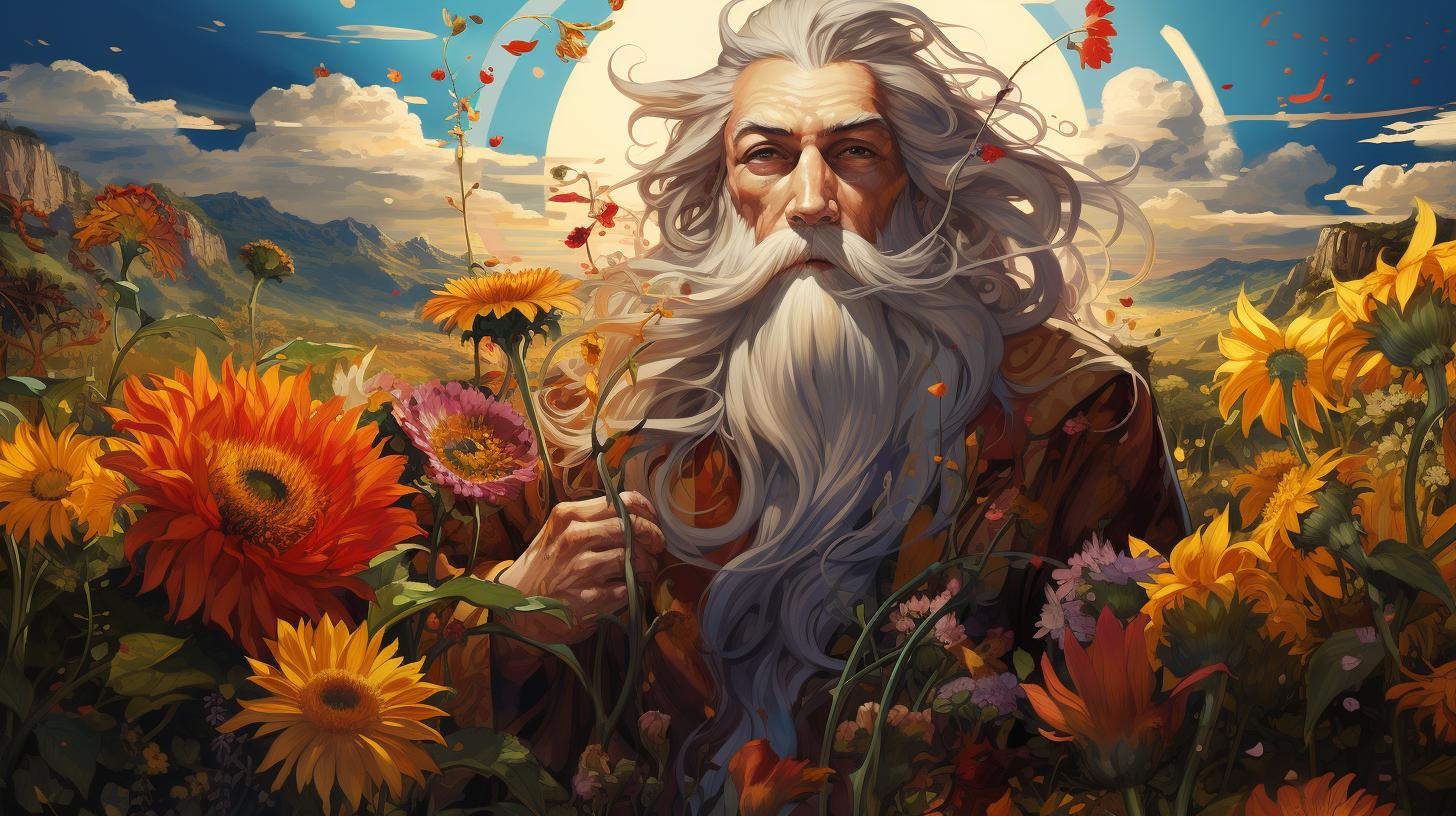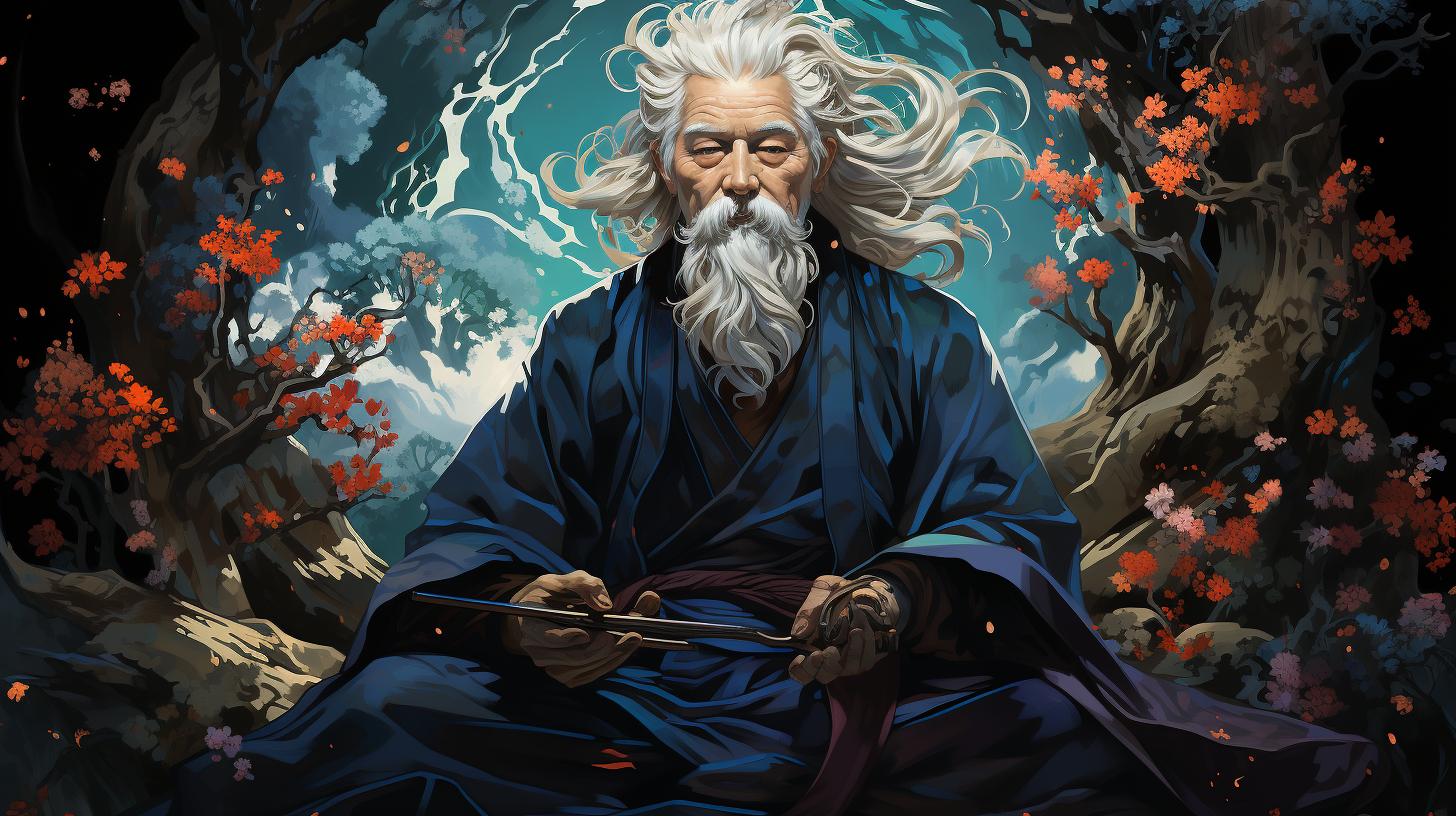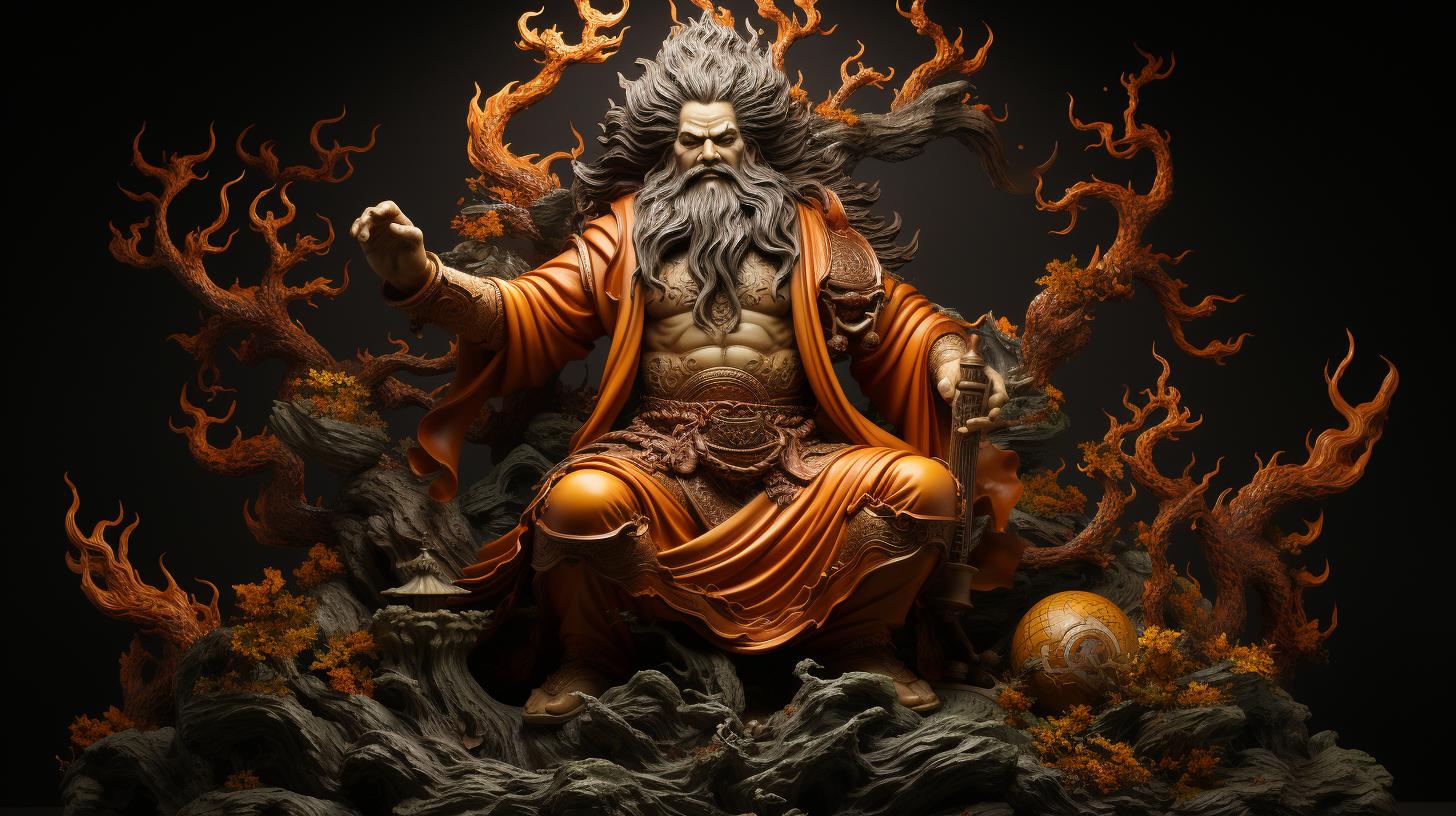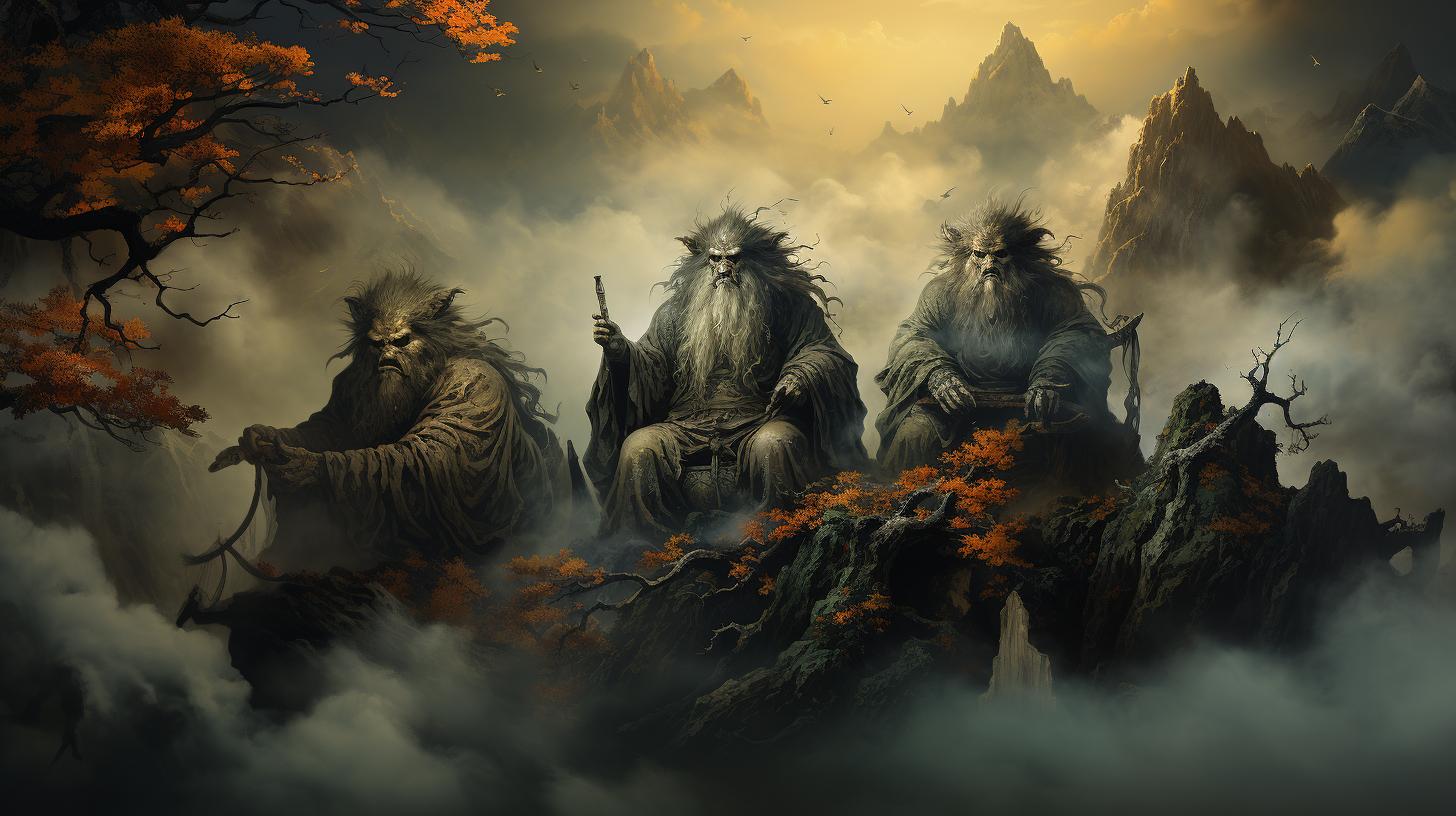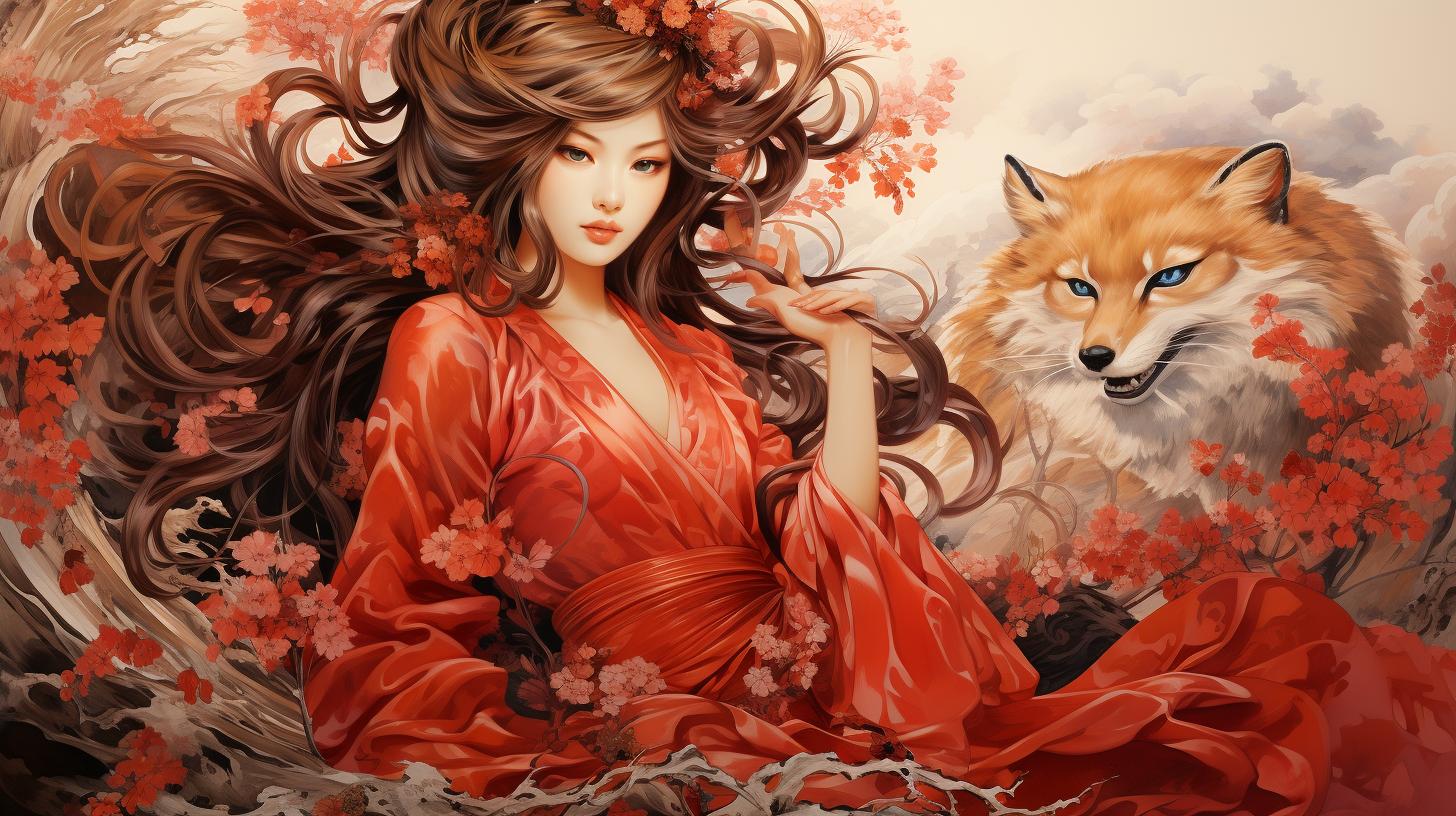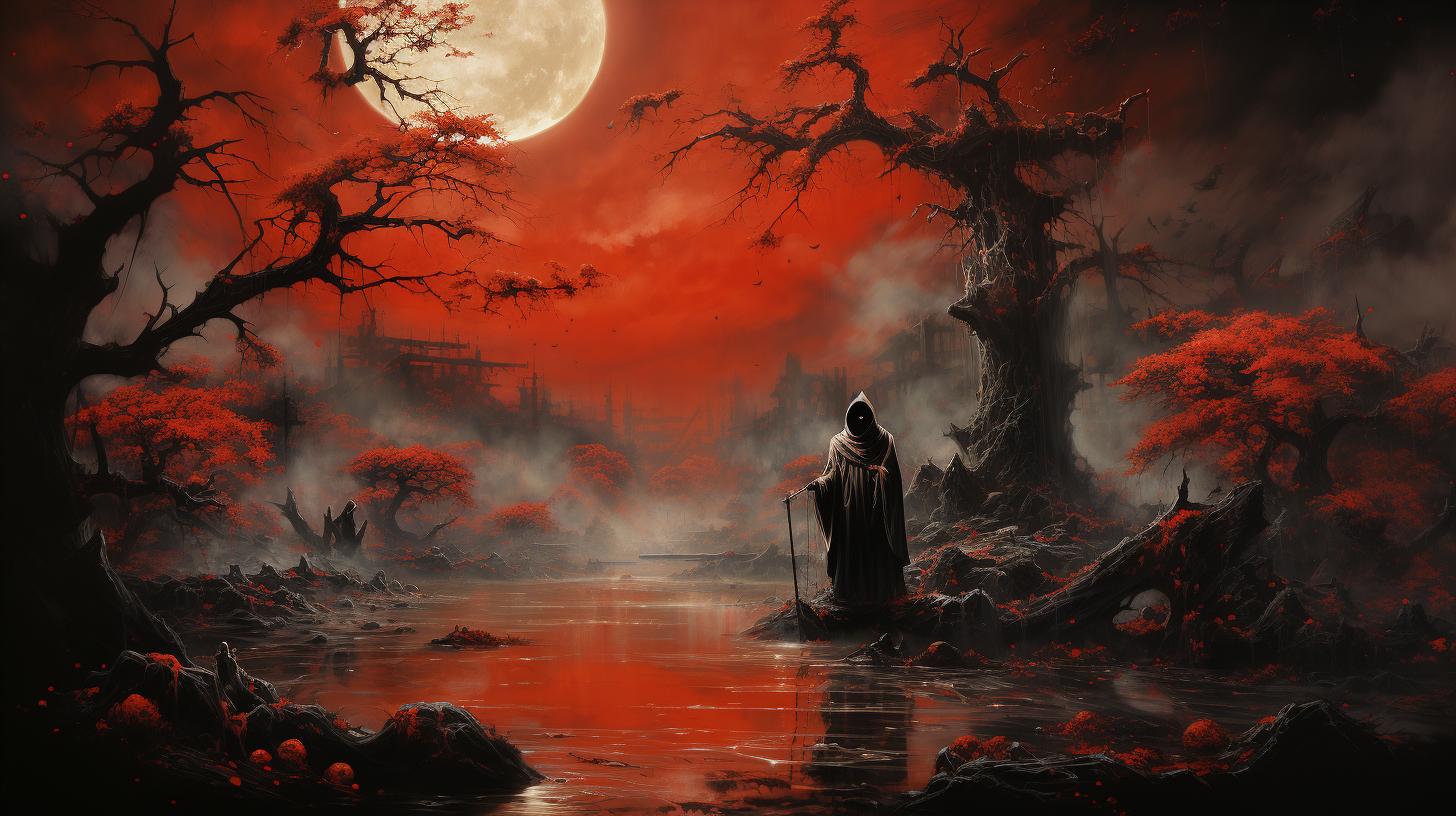Hachiman Japanese God of War: Unveiling the Mythical Warrior’s Legacy
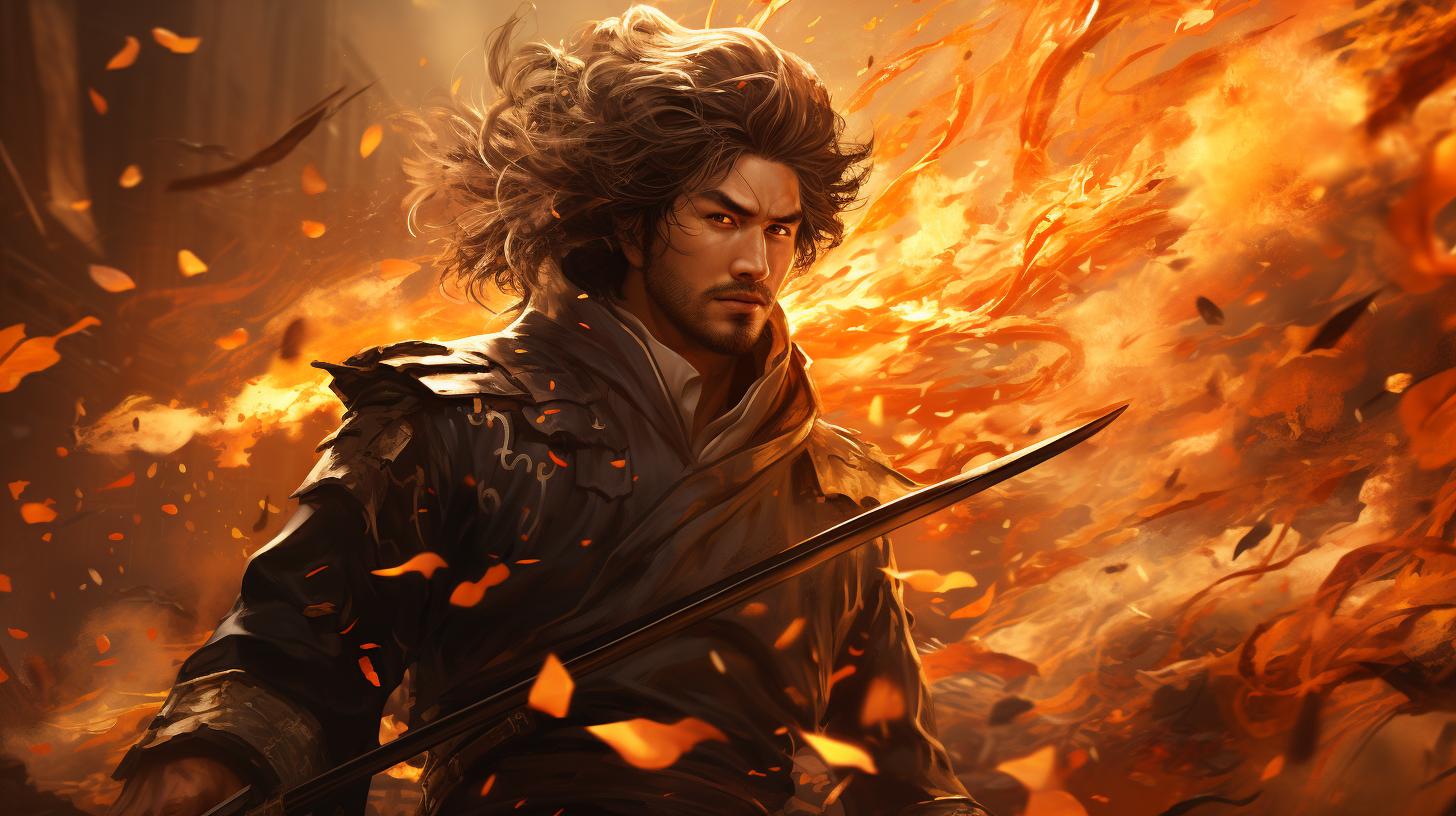
Hachiman, the Japanese God of War, holds a significant place in both mythology and history. From ancient times, Hachiman has been revered for his origins and role in Japan, as well as his connection to the Imperial Family.
The Hachiman Shrine stands as a symbol of his significance, while his influence on samurai culture and the syncretism of Shinto and Buddhism in his worship is widely recognized. Beyond Japan, Hachiman’s worship and legacy have expanded, leaving an enduring impact on Japanese society and even reaching the shores of the USA.
Hachiman: The Japanese God of War
Hachiman, known as the Japanese God of War, holds a prominent place in Japanese mythology and history. This revered deity is a fascinating figure, embodying the essence of martial prowess, honor, and protection.
Worship of Hachiman dates back centuries, making him an integral part of Japan’s cultural and religious heritage.
As a god associated with war, Hachiman symbolizes strength, bravery, and victory. He is often depicted as a fierce warrior adorned in traditional samurai armor, wielding a bow and arrow.
The tales and legends surrounding Hachiman reflect his role as a protector and patron of warriors.
Hachiman’s origins trace back to ancient Japan, where his worship began as early as the 8th century.
He gained popularity during the Heian period, becoming particularly revered during the Kamakura Shogunate. One of the distinctive aspects of Hachiman’s mythology is his close connection to the Imperial Family, as his worship was linked to the prosperity and divine protection of the ruling lineage.
The Hachiman Shrine, dedicated to this powerful god, serves as a focal point for worship and reverence. These shrines, found throughout Japan, are known for their unique architecture and serene surroundings.
Visiting these sacred sites offers a glimpse into the religious and cultural significance of Hachiman.
The influence of Hachiman extended beyond the realm of mythology and religion. His association with the Minamoto Clan, a prominent samurai family, elevated his status as a guardian of the samurai class and a unifying force within society.
Hachiman’s worshippers often sought his blessings for victory in battles and protection against adversaries.
The syncretism of Shinto and Buddhism played a vital role in Hachiman worship. The amalgamation of these two religions resulted in a unique blend of beliefs and practices, further emphasizing Hachiman’s divine qualities and his importance as a deity revered by both samurai and commoners.
Even beyond the borders of Japan, Hachiman’s influence has spread. In modern times, Japanese immigrants have carried their cultural traditions, including the worship of Hachiman, to the United States. Hachiman’s legacy continues to be celebrated in various forms, including festivals, art, and popular culture.
Exploring Hachiman’s significance and his enduring impact on Japanese society offers a captivating journey into the realm of ancient myths, warriors, and spiritual devotion. As we delve into the intricacies of his mythology and cultural importance, we gain a deeper understanding of Japan’s rich heritage and the enduring legacy of Hachiman, the Japanese God of War.
Hachiman in Japanese Mythology
Hachiman, as a deity, holds a significant place in Japanese mythology. He is often recognized as the God of War, a revered figure representing military prowess, protection, and victory. In Japanese folklore, Hachiman is believed to have descended from the heavens, manifested in the gentle waves of the sea.
In ancient Japanese mythology, Hachiman is closely associated with Emperor Ōjin, who is considered his human form. Legends tell the tale of Hachiman’s divine birth as the son of Empress Jingu and Emperor Chūai after she encountered a mystical white dove.
This divine connection with the Imperial Family established Hachiman’s role as a protector and benefactor to the nation.
Unlike other deities, Hachiman’s presence extends beyond war and martial prowess. He is often depicted as embodying virtues such as justice, wisdom, and benevolence, making him an esteemed figure not only in times of conflict but also in matters of governance and social well-being.
- Hachiman’s divine presence in Japanese mythology is often linked to his association with Emperor Ōjin.
- Legends surrounding Hachiman’s birth as the son of Empress Jingu and Emperor Chūai highlight his divine lineage.
- Hachiman’s influence extends beyond warfare, encompassing principles of justice, wisdom, and benevolence.
Throughout history, Hachiman’s mythical deeds and divine heritage have solidified his status as a revered deity in Japanese culture.
His unique connection to the Imperial Family and his multifaceted qualities attract immense reverence and worship from people even in modern times. Understanding Hachiman’s origins and mythological significance is crucial in comprehending the profound impact he continues to have on Japanese society.
Hachiman’s Origins and Role in Ancient Japan
Hachiman possesses a rich and intriguing history in ancient Japan, with origins rooted in both myth and legend. The deity’s beginnings can be traced back to the 6th century, during the reign of Emperor Yuryaku.
According to legend, Hachiman was believed to be the syncretic amalgamation of two deities: Ōjin, the 15th emperor of Japan, and his mother, Empress Jingū. This divine fusion resulted in the birth of Hachiman, who would go on to become the patron god of warriors and protectors of the Japanese people.
In ancient Japan, Hachiman played a crucial role in ensuring the nation’s safety and well-being. He was considered the divine guardian of the Yamato dynasty, the imperial family, and the Japanese people as a whole.
As the god of war, Hachiman was revered as a mighty force who possessed the ability to guide and inspire troops on the battlefield. This martial prowess made him a highly respected and feared deity, greatly influencing the events and outcomes of conflicts throughout ancient Japanese history.
Hachiman’s significance extended beyond his role as a god of war. He was also regarded as a deity associated with agriculture, prosperity, and society. This multifaceted nature of Hachiman’s divine persona further solidified his importance within the culture and daily lives of the ancient Japanese people.
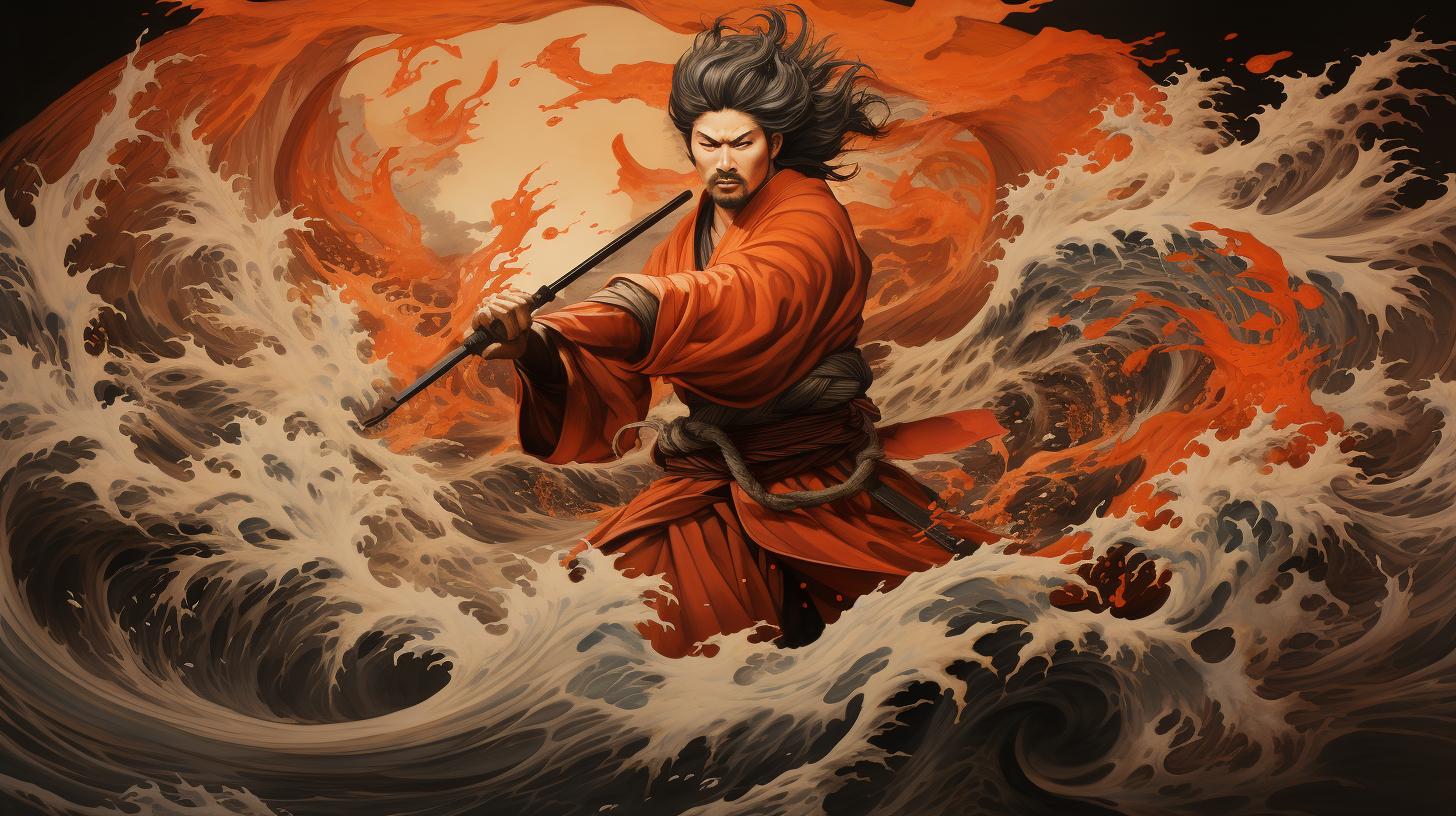
His divine presence brought hope, protection, and blessings to those who worshipped him, fostering a sense of unity and reverence among the populace.
The worship of Hachiman during ancient times was not limited to the battlefield or the imperial court.
It permeated various spheres of ancient Japanese society. From the samurai class to the common folk, Hachiman’s influence spanned across different social strata, shaping the moral and ethical values upheld by the people.
The ancient origins of Hachiman set the stage for his enduring legacy, which continues to resonate with the Japanese people to this day. Though the world has evolved and changed throughout centuries, the reverence for Hachiman persists, a testament to the lasting impact of this ancient Japanese god of war.
Hachiman’s Connection to the Imperial Family
One of the most notable aspects of Hachiman, the Japanese God of War, is his close connection to the Imperial Family. Throughout history, the Imperial Family of Japan has revered Hachiman as one of their patron deities, associating him with their lineage and earthly rule.
The connection between Hachiman and the Imperial Family can be traced back to ancient times when Emperor Ōjin, who was regarded as the father of Hachiman, ruled over Japan. According to legends, Emperor Ōjin was believed to be an incarnation of Hachiman himself, solidifying the god’s association with the Imperial Family.
During the Heian period, Hachiman’s prominence grew even further as Emperor Kanmu declared him to be the protector of the nation and granted him the status of the “God of War.”
This official recognition enhanced the prestige of Hachiman and solidified his place within the Imperial Court.
Throughout the centuries, the Imperial Family continued to pay homage to Hachiman, seeking his divine protection and guidance in times of war and political turmoil.
The Emperors would often visit Hachiman Shrines, such as the famous Iwashimizu Hachiman-gū, to offer prayers and perform rituals, symbolizing their devotion and belief in Hachiman’s divine power.
Furthermore, Hachiman’s connection to the Imperial Family extended beyond mere religious reverence.
In times of conflict, the Imperial Court would call upon Hachiman’s spiritual support, considering him an essential ally in ensuring victory on the battleground. The god’s association with war and military prowess made him an indispensable figure during periods of military campaigns and territorial expansion.
Even in modern Japan, Hachiman continues to be an important spiritual figure for the Imperial Family. His role as a protector and patron deity remains relevant, reminding people of the deep-rooted traditions and historical significance tied to the Japanese monarchy.
Overall, Hachiman’s connection to the Imperial Family illustrates the interwoven relationship between religion, mythology, and political power in Japanese history. His position as a guardian deity and symbol of martial strength has played a vital role in shaping the perception of the Imperial Family and their role as leaders throughout the ages.
The Hachiman Shrine and its Significance
The Hachiman Shrine stands as a revered symbol of Japan’s rich cultural and religious history. Dedicated to Hachiman, the Japanese God of War, this sacred shrine holds great significance and attracts worshippers from all over the country.
Located in various regions across Japan, Hachiman Shrines serve as spiritual sanctuaries, embodying the ancient traditions and beliefs associated with Hachiman. The architectural design of these shrines typically follows a distinct Shinto style, characterized by torii gates, wooden structures, and serene gardens.
Inside the shrine precincts, visitors can often witness various religious rituals and ceremonies paying homage to Hachiman. The atmosphere is filled with reverence as devotees offer prayers and make offerings to seek protection, martial prowess, and victory in battle.
- The unique feature of Hachiman Shrines is the fusion of Shinto and Buddhist elements. This syncretism reflects the historical integration of these two influential religions in Japan.
- The main hall of the shrine, known as the honden, houses the enshrined deity and is the focal point of worship.
Within the honden, sacred relics and artifacts associated with Hachiman are displayed, showcasing the deity’s connection to warfare and the Imperial Family.
- As Hachiman is considered the divine protector of the nation, many Hachiman Shrines are strategically located near the borders or in significant historical locations, signifying their role in safeguarding lands, people, and traditions.
- In addition to their religious significance, Hachiman Shrines also serve as cultural landmarks, attracting tourists and history enthusiasts who seek to explore Japan’s ancient heritage and learn about the myths, legends, and historical events associated with Hachiman.
Overall, the Hachiman Shrine stands as a testament to Japan’s profound reverence towards Hachiman, the God of War.
Its architectural beauty, spiritual ambiance, and historical importance make it a must-visit destination for those seeking a deeper understanding of Japan’s cultural and religious roots.
Hachiman and the Minamoto Clan
The Minamoto Clan, also known as the Genji Clan, played a crucial role in the history of Japan and their association with Hachiman, the Japanese God of War, was deeply significant.
The Minamoto Clan, descending from Emperor Seiwa, rose to power during the late Heian period, and their close bond with Hachiman became the cornerstone of their military prowess and authority.
Minamoto no Yoshiie
The esteemed warrior, Minamoto no Yoshiie, played a pivotal role in solidifying the Clan’s connection with Hachiman.
Renowned for his bravery and strategic brilliance, Yoshiie became one of Hachiman’s most devoted followers, seeking divine assistance and guidance for the Clan’s victories on the battlefield.
Hachiman and the Gempei War
The Gempei War, a famous conflict between the Minamoto and Taira Clans, further strengthen the spiritual alliance between Hachiman and the Minamoto.
It was believed that Hachiman himself supported the Minamoto Clan, granting them divine protection and favor in their quest for victory against their rivals.
The Rise of the Kamakura Shogunate
Following their triumph in the Gempei War, the Minamoto Clan ascended to power, establishing the Kamakura Shogunate. This marked a significant turning point in Japanese history, with Hachiman’s influence felt not only in military affairs but also in shaping the political landscape of the country.
Samurai and Hachiman Worship
Hachiman’s association with the Minamoto Clan greatly impacted the samurai class, who revered him as their patron deity. As warriors who embodied loyalty, bravery, and honor, the samurai saw themselves as devoted followers of Hachiman, believing that his divine blessings endowed them with extraordinary strength and skill in battle.
Hachiman Shrines and the Minamoto Clan
The Minamoto Clan, recognizing Hachiman’s significance in their success, supported the construction of numerous shrines dedicated to the deity throughout Japan. These shrines served as focal points for the Clan’s worship, reinforcing their spiritual bond and perpetuating Hachiman’s legacy as the God of War.
In conclusion, the Minamoto Clan’s close affiliation with Hachiman, the Japanese God of War, indelibly shaped their history and the destiny of Japan. From their rise to power during the late Heian period to their pivotal role in the Gempei War, the Clan’s devotion to Hachiman exemplified the intertwining of religion, politics, and military affairs during this era.
Hachiman’s influence on the Minamoto Clan and the samurai culture reverberates to this day, leaving an enduring imprint on Japanese society and its perception of war and martial prowess.
Hachiman’s Influence on Samurai Culture
Hachiman, the Japanese God of War, held immense influence on the culture and practices of the esteemed samurai warriors.
As dedicated and disciplined fighters, the samurai looked up to Hachiman as their divine patron, seeking his guidance, protection, and favor in battle.
1. Inspiration for Bushido: Hachiman’s embodiment of courage, honor, and loyalty deeply influenced the samurai code of conduct known as Bushido.
The warrior class adhered to these principles, which emphasized integrity, selflessness, and martial prowess.
2. Hachiman Shrines: Throughout Japan, numerous Hachiman shrines were built specifically to honor the God of War.
These sacred places served as gathering points for the samurai, who would pay respects, pray for victory, and seek blessings for their valor and success on the battlefield.
3. Rituals and Offerings: The samurai performed rituals and made offerings at Hachiman shrines to seek divine protection and guidance.
They believed that by demonstrating their dedication and loyalty, they would receive Hachiman’s favor in the form of victory in battle and personal strength.
4. Education and Training: Hachiman’s influence also extended to the education and training of samurai warriors.
Schools and training academies incorporated teachings on Hachiman’s legendary battles and heroic feats, inspiring the samurai to emulate his bravery and skill in their own combat practices.
5. Battle Standards and Symbols: The iconic image of Hachiman on horseback, wielding a bow and arrow, became a symbol that represented the samurai’s commitment to honor, justice, and martial prowess.
Many samurai displayed Hachiman’s emblem on their battle standards and armor as a source of inspiration and protection.
6. Patronage of Warriors: Hachiman was considered the patron deity of warriors, and samurai warriors dedicated their loyalty and allegiance to him.
They believed that serving Hachiman would not only ensure victory in battle but also maintain their social status and honor within their clans.
7. National Unity: Hachiman’s worship brought together warriors from different clans and regions, fostering a sense of unity and shared purpose among the samurai.
The God of War became a unifying force that transcended individual loyalties, promoting a collective identity as defenders of Japan.
The influence of Hachiman on samurai culture was profound, shaping their values, rituals, and mindset.
The reverence for this divine God of War played a crucial role in defining the identity and legacy of the samurai warriors throughout Japan’s history.
The Syncretism of Shinto and Buddhism in Hachiman Worship
Hachiman worship in Japan provides an intriguing example of the syncretism between Shinto and Buddhism.
Shinto, the indigenous religion of Japan, and Buddhism, which was introduced from India, coexist harmoniously in the veneration of Hachiman, the Japanese God of War.
Shintoism, with its reverence for kami (spirits), had long been intertwined with Japan’s cultural and spiritual fabric.
When Buddhism arrived in Japan in the 6th century, it gradually assimilated into the existing belief system. This syncretism resulted in a unique form of religious practice that combined elements from both Shinto and Buddhism.
Hachiman, originally a Shinto deity associated with agriculture and the harvest, gained prominence as a protector of the nation and a revered war deity during Japan’s historical conflicts. As his popularity grew, Hachiman became deeply entwined with Buddhist teachings and rituals, further solidifying the syncretic nature of his worship.
The fusion of Shinto and Buddhism in Hachiman worship is evident in various aspects. Hachiman shrines often feature Buddhist architectural elements, such as torii gates and pagodas, alongside Shinto sacred symbols.
Long-standing Buddhist rituals, such as sutra chanting and meditation, coexist with Shinto practices of purification and ritual offerings.
- This syncretism can be observed in the religious ceremonies held at Hachiman shrines, where Buddhist priests and Shinto priests collaborate to conduct rituals.
- Prayer rituals often involve recitations of both Buddhist sutras and Shinto prayers, demonstrating the inclusive nature of Hachiman worship.
- Icons and statues of Hachiman often depict him in a blend of Shinto and Buddhist symbolism, reflecting the shared aspects of both religions.
The syncretic nature of Hachiman worship reflects the historical and cultural intertwining of Shinto and Buddhism in Japan.
It highlights the adaptability and flexibility of religious belief systems, as well as the willingness of different religious traditions to coexist and enrich one another.
Hachiman’s Expansion and Worship Beyond Japan
Hachiman, the revered Japanese God of War, not only held great influence within Japan’s borders but also saw his worship extend beyond its shores.
As Japan engaged in diplomatic relations and trade with other countries, Hachiman’s popularity transcended national boundaries.
One notable example of Hachiman’s expansion can be seen in his worship at the Hachiman Shrine in Lushun, China.
Established during the Tang dynasty, this shrine served as a symbol of friendship and cooperation between Japan and China. The dedicated Hachiman followers erected this shrine to honor their god and engage in cultural exchange.
During the 8th century, as Japan’s influence grew in the Korean Peninsula, Hachiman worship spread there as well. The Kingdom of Silla embraced Hachiman as a guardian deity and acknowledged his role in protecting their land.
This led to the construction of Hachiman shrines and the incorporation of Hachiman rituals into the local traditions.
As the Japanese diaspora started to flourish, particularly during the late 19th and early 20th centuries, Hachiman worship expanded to various overseas Japanese communities.
Immigrants brought their religious practices with them, including the veneration of Hachiman. Today, Hachiman shrines can be found in countries such as the United States, Canada, Brazil, and Australia, serving as a connection to their cultural roots and ancestral heritage.
Furthermore, Hachiman’s influence on neighboring countries, such as Korea and China, led to the assimilation of certain Hachiman aspects into their own beliefs and mythologies. These cultural exchanges enriched their understanding of warfare and provided inspiration for their own warrior traditions.
The expansion of Hachiman’s worship beyond Japan stands as a testament to the god’s enduring legacy and the admiration he garnered. As followers and devotees maintained their faith in distant lands, Hachiman continues to inspire and influence individuals, fostering a sense of unity and cultural identity.
Hachiman’s Archery and Martial Prowess
Hachiman, the Japanese God of War, is widely revered for his exceptional archery and martial prowess. Known as an expert marksman and skilled warrior, Hachiman’s proficiency with the bow and arrow is legendary.
According to Japanese mythology, Hachiman was a master archer who could strike down his enemies with remarkable precision. His divine arrows were said to be imbued with spiritual power, making them deadly and unstoppable.
In ancient Japan, archery played a pivotal role in warfare, and Hachiman’s connection to this art form made him a revered figure among warriors. He inspired countless samurai with his exceptional skill and became a symbol of victory and military success.
The disciplined training of archery was not only a physical practice but also a spiritual one. Many samurai believed that through mastering the art of archery, they could align their minds and bodies with Hachiman’s divine power, gaining an edge in battle.
- Hachiman’s prowess with the bow and arrow elevated him to the status of a deity that warriors sought favor from before engaging in battle.
- Samurai would often offer prayers and make offerings at Hachiman shrines to receive blessings and guidance in their military endeavors.
- Apart from its practical application in warfare, archery also had a symbolic significance in Japanese culture, representing discipline, focus, and spiritual alignment.
Even today, Hachiman’s archery skills continue to be celebrated and admired in Japan.
Archery competitions and festivals are held across the country, paying homage to the god’s remarkable talent.
Hachiman’s reputation as a formidable war deity, coupled with his mastery of archery, remains an integral part of his divine persona.
His legacy as a symbol of martial excellence and strategic insight continues to inspire individuals in their pursuit of physical and spiritual strength.
Hachiman Shrines Dedicated to War and Victory
The Hachiman shrines hold a significant place in Japanese culture, particularly for their dedication to war and victory. These sacred sites, scattered throughout Japan, serve as important pilgrimage destinations for those seeking divine protection and success in warfare.
The architecture and design of Hachiman shrines reflect their purpose, often featuring impressive torii gates, stone lanterns, and expansive grounds. These structures exude a sense of power and reverence, capturing the essence of Hachiman as the god of war.
Visitors are welcomed by the solemn atmosphere and the air thick with history and the spirits of past warriors.
Within the shrines, one can find various symbols and artifacts representing the association with war and victory.
These include intricately crafted samurai armor, swords, and battle standards. These displays serve as reminders of Hachiman’s support and guidance to the warriors, motivating them in their pursuit of triumph on the battlefield.
- The main hall of the Hachiman shrine is the central point of worship. Here, fervent prayers are offered to seek the god’s blessings, ensuring success and protection in times of conflict.
- Visitors often make offerings of sake, weapons, and personal items at the shrines, expressing their loyalty and commitment to the god’s cause.
- War-related festivals and ceremonies are held at these sacred sites, attracting participants from all walks of life.
These events celebrate the spirit of warriorhood and honor the memories of legendary battles.
- Pilgrims and devotees believe that by paying homage to Hachiman at these shrines, they can gain favor in warfare, securing favorable outcomes and victories.
The Hachiman shrines dedicated to war and victory serve as reminders of the deep-rooted connection between spirituality, warfare, and the samurai way of life.
Their existence preserves the traditions and beliefs that shaped Japan’s history, honoring the god of war and ensuring his continued influence in the lives of those who seek strength, protection, and success in battle.
The Spread of Hachiman Worship During the Kamakura Shogunate
During the Kamakura Shogunate, which lasted from 1192 to 1333, the worship of Hachiman experienced a significant expansion throughout Japan. This period marked a turning point in the history of Hachiman, as the popularity of samurai and their influence grew.
The Kamakura Shogunate was characterized by a feudal system in which the military rulers, known as the shoguns, held the real power. These shoguns sought to strengthen their authority and legitimacy by connecting themselves to the divine.
Hachiman, the god of war, became a central figure in their mission.
One of the key factors that fueled the spread of Hachiman worship during this time was the support and endorsement of the Kamakura shoguns themselves.
They actively promoted the deity as their patron, thereby encouraging their subjects to venerate Hachiman as well. This led to the construction of numerous Hachiman shrines across the country, further solidifying his position as a national deity.
- These newly established Hachiman shrines served as important centers of worship, not only for the samurai class but also for commoners. The shoguns made efforts to involve the general public in Hachiman veneration, ensuring its widespread adoption.
- The Hachiman shrines became gathering places, where people would come to pray for military success, protection, and prosperity.
The connection between Hachiman and warfare became even stronger during this period.
- The spread of Hachiman worship was not limited to physical shrines. The influence of samurai and their devotion to Hachiman extended to other aspects of daily life, including poetry, literature, and art.
The Kamakura period witnessed the rise of warrior culture, and Hachiman, considered the patron god of warriors, played a central role in shaping this culture.
The samurai class revered Hachiman as their guardian deity, and his influence permeated every aspect of their lives.
The expansion of Hachiman worship during the Kamakura Shogunate laid the foundation for his continued prominence in later periods of Japanese history.
The combination of samurai admiration and official support from the ruling powers ensured that Hachiman remained deeply ingrained in the nation’s religious and cultural fabric.
Hachiman in Japanese Folklore and Popular Culture
Hachiman, the Japanese God of War, has held a prominent place in Japanese folklore and popular culture for centuries.
From ancient tales to modern adaptations, Hachiman’s legends and symbolism continue to captivate audiences.
In Japanese folklore, Hachiman is often depicted as a mighty warrior, revered for his bravery, strategic prowess, and sense of justice.
His stories are frequently featured in traditional folktales, where he takes on various adversaries and emerges victorious, embodying the archetypal hero figure.
One famous tale is the legend of Emperor Ojin, who is said to be a reincarnation of Hachiman.
According to the story, Emperor Ojin possessed extraordinary martial skills and led Japan to numerous victories. This legend reinforces the association between Hachiman and military success.
Hachiman’s influence extends beyond folklore and permeates various forms of Japanese popular culture.
In literature, he often appears as a revered deity, offering guidance and protection to the protagonist in historical novels or fantasy stories. His presence adds depth and authenticity to these narratives, imbued with the spirit of ancient Japan.
Hachiman’s iconic image is also prominent in visual arts, particularly in traditional Ukiyo-e woodblock prints. These prints often showcase Hachiman’s stern expression, clad in samurai armor, ready for battle. Such artwork not only pays homage to Hachiman’s divine status but also captures the essence of feudal Japan’s warrior culture.
In modern Japan, Hachiman continues to hold significance in festivals and celebrations. The annual Hachiman Matsuri, or Hachiman Festival, is a vibrant event where communities come together to honor the deity through parades, performances, and traditional rituals.
These festivities serve as a reminder of Hachiman’s enduring legacy and the importance of martial spirit in Japanese society.
Moreover, Hachiman’s influence is also evident in contemporary media, such as manga, anime, and video games.
Countless fictional characters draw inspiration from Hachiman, embodying his warrior attributes and valor. These portrayals contribute to the ongoing popularity and relevance of Hachiman in modern pop culture.
- Hachiman’s legends continue to inspire epic storylines and captivating characters in Japanese folklore.
- Traditional art forms pay tribute to Hachiman, capturing the essence of Japan’s warrior culture.
- The annual Hachiman Festival serves as a vibrant celebration of the deity’s enduring legacy.
- Hachiman’s influence extends to contemporary media, where fictional characters embody his heroic attributes.
Hachiman in Modern Japan and the USA
Hachiman, the Japanese God of War, continues to hold great significance in modern Japan and has, to some extent, made an impact beyond its borders, reaching the United States.
While the worship of Hachiman has evolved over time, it remains an integral part of Japanese culture and carries a rich legacy.
In modern Japan, Hachiman is revered not only as a deity associated with war but also as a protector and guardian of the nation.
Many Hachiman shrines can be found throughout Japan, serving as focal points for worship and cultural festivities. These shrines attract a large number of visitors, both locals and tourists alike, seeking blessings, offering prayers, and exploring the rich history associated with the God of War.
Furthermore, Hachiman’s influence extends beyond religious practices. The values attributed to Hachiman, such as bravery, loyalty, and honor, continue to resonate with the Japanese society. Many Japanese people look up to Hachiman as a symbol of strength and inspiration, particularly in times of national and personal challenges.
In the United States, the significance of Hachiman can be observed within the Japanese diaspora. Japanese communities and cultural centers often embrace their traditions and religious practices, including the worship of Hachiman.
Festivals dedicated to Hachiman or samurai culture showcase the enduring influence of this legendary deity.
The Cultural Exchange: Samurai, Hachiman, and the USA
The fascination with samurai culture in the United States has played a role in bringing Hachiman’s legacy to this country. The martial arts, including traditional Japanese swordsmanship, have gained popularity, and Hachiman’s association with warfare and martial prowess has captured the imagination of many.
Samurai-themed events, exhibitions, and movies have helped spread awareness of Hachiman and his role as the Japanese God of War. These cultural exchanges contribute to a greater understanding of Japanese history, mythology, and the significance of Hachiman’s worship among both Americans of Japanese descent and enthusiasts of Japanese culture.
- Japanese martial arts dojos teach not only physical techniques but also the virtues and mindset associated with samurai warriors, drawing from Hachiman’s inspiration.
- Museums and exhibitions in the United States showcase artifacts, paintings, and sculptures depicting Hachiman and his influence on Japanese society.
- Anime, manga, and video games often incorporate Hachiman as a character or reference, further cementing his presence in popular culture and reaching a wider audience.
Through various mediums, the story of Hachiman, the Japanese God of War, continues to captivate people’s fascination and inspire reverence for this enigmatic figure.
Whether in Japan or the United States, Hachiman’s legacy serves as a reminder of the complex historical and cultural tapestry that has shaped both nations.
Hachiman’s Legacy and Impact on Japanese Society
Hachiman, the Japanese God of War, has left a profound legacy and made a significant impact on Japanese society throughout history.
From his origins as a mythical warrior deity to his association with the Imperial Family, Hachiman’s influence can be felt in various aspects of Japanese culture.
One of the most tangible expressions of Hachiman’s legacy is the presence of Hachiman Shrines, dedicated to his worship.
These sacred places serve as spiritual hubs, fostering a sense of community and reinforcing a deep connection to the country’s martial traditions. The Hachiman Shrines, scattered across Japan, continue to attract devotees and visitors seeking solace, protection, and guidance.
Moreover, Hachiman played a pivotal role in shaping the samurai culture of ancient Japan. As the patron god of warriors, he embodied their values of honor, discipline, and loyalty. Hachiman’s teachings and influence on the samurai code influenced the conduct and ethics of these elite warriors, shaping the path of Japan’s feudal history.
Hachiman’s worship also showcases the syncretism of Shinto and Buddhism in Japanese religious practices. The fusion of these two belief systems, known as Shinbutsu-shūgō, is exemplified in Hachiman Shrines, where Shinto rituals coexist with Buddhist influences.
This integration reflects the adaptability and coexistence of different spiritual traditions within Japanese society.
As Japan expanded its territory and societal influence, Hachiman’s worship spread beyond its borders. During the Kamakura Shogunate, Hachiman’s popularity reached new heights as he became the guardian deity of the Minamoto Clan.
This period marked the widespread proliferation of Hachiman Shrines throughout Japan, reinforcing his status as a unifying symbol and protector of the nation.
Hachiman’s enduring presence extends beyond ancient times, finding its way into modern Japanese society and even reaching the United States.
His imagery and stories are often featured in Japanese folklore, literature, and popular culture, reminding people of the warrior spirit and the values he represents.
In modern Japan, Hachiman continues to inspire a deep sense of pride and national identity.
His legacy serves as a reminder of Japan’s historical heritage and the resilience of its people. The reverence and admiration for Hachiman embody the timeless reverence towards the warrior spirit and the ideals it upholds.
In conclusion, Hachiman, the Japanese God of War, has left an indelible legacy and cast a profound impact on Japanese society. Through his role as a protector, influencer of samurai culture, and symbol of national pride, Hachiman’s legacy persists, shaping the values, traditions, and spiritual landscape of Japan even in the modern era.
.











